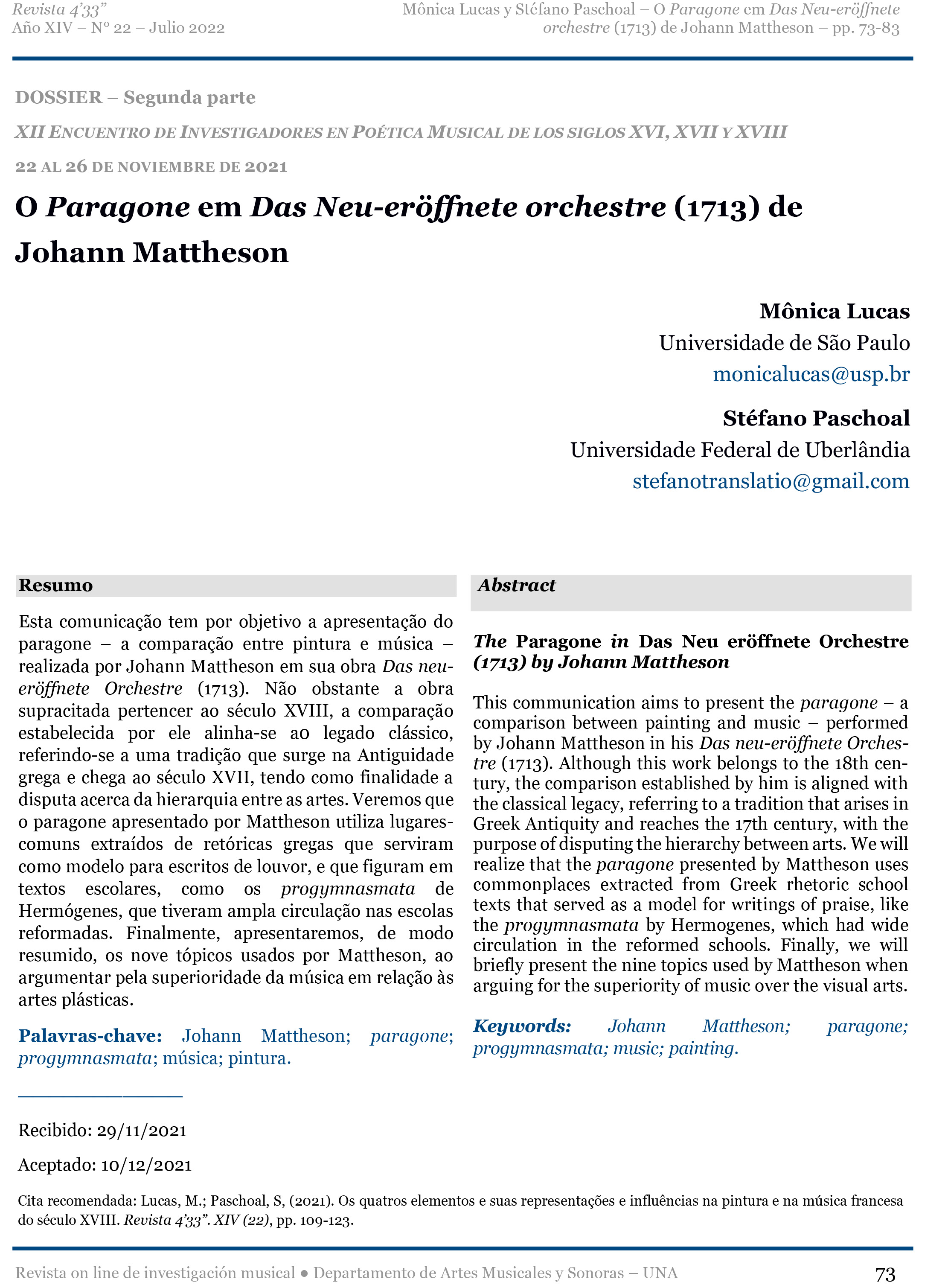O Paragone em Das Neu-eröffnete orchestre (1713) de Johann Mattheson
Palabras clave:
Mattheson, paragone, progymnasmata, música, pintura, music, paintingResumen
Este trabalho se concentra na investigação da noção de actio na música instrumental setecentista a partir das preceptivas de Quantz (1752) e Mattheson (1739). Nes-ses tratados é possível observar a relação entre a atua-ção do orador e do cantor/instrumentista. Segundo es-ses autores, o discurso – verbal ou musical - é comple-tado pela ação, havendo certa liberdade para a repre-sentação segundo a sensibilidade e o bom gosto. Quantz descreve as qualidades esperadas no proferimento do discurso que evitam a monotonia, dentre as quais desta-camos as mais úteis para a música instrumental: as nu-ances de tons e intensidade do som; e a variedade rít-mica. A importância dessa variedade no momento da ação pode ser observada em diferentes passagens no tra-tado de Quantz, como quando ele menciona as notas lentas e cantábiles que intercalam as passagien dos al-legros; e quando ele discorre sobre o acompanhamento do solo - que deve favorecer a liberdade do solista para ousar e variar o tempo. Mattheson também faz referên-cia à liberdade de tempo quando escreve que o instru-mentista deve assumir um estilo de canto flexível nos adágios ao invés de um tempo exato; e também quando menciona o estilo livre das fantasias. A variedade de tons (da voz ou do som) é detalhadamente indicada e exemplificada por Quantz no capítulo dedicado aos mo-vimentos lentos, onde ele defende o uso de forte/fraco além de crescendo/decrescendo, a fim de variar o proferimento do discurso musical alternando luz e sombra – assunto também destacado por Mattheson, para quem os poemas sonoros são pinturas musicais onde a pala-vra é como o desenho e os sons como as cores.
ABSTRACT
Actio in Eighteenth-century Instrumental Music: Nuances of Tones and Rhythmic Variety According to Quantz and Mattheson's Precepts
This paper focuses on the investigation of the notion of actio in eighteenth-century instrumental music accord-ing to the precepts of Quantz (1752) and Mattheson (1739). In these treatises, it is possible to observe the re-lationship between the performances of the speaker and the singer/instrumentalist. According to these au-thors, speech – verbal or musical – is completed by ac-tion, with a certain freedom for representation accord-ing to sensitivity and good taste. Quantz describes the expected qualities in the delivery of speech that avoid monotony, among which we highlight the most useful for instrumental music: the nuances of tone and inten-sity of sound; and the rhythmic variety. The im-portance of this variety in the moment of action can be seen at different excerpts of Quantz's treatise, as when he mentions the slow, singsong notes that intersperse the passagien of the allegros; and when he talks about the accompaniment of the solo - which should favor the soloist's freedom to dare and vary the tempo. Matthe-son also makes reference to freedom of tempo when he writes that the instrumentalist should assume a flexible singing style in adagios rather than an exact tempo; and also when mentioning the freestyle of fantasias.
The variety of tones (voice or sound) is exemplified in detail by Quantz in the chapter dedicated to slow move-ments, where he advocates the use of strong/weak as well as crescendo/decrescendo, in order to vary the de-livery of musical speech by alternating light and shadow – a subject also highlighted by Mattheson, for whom sound poems are musical paintings where words are like drawings and sounds like colors.


